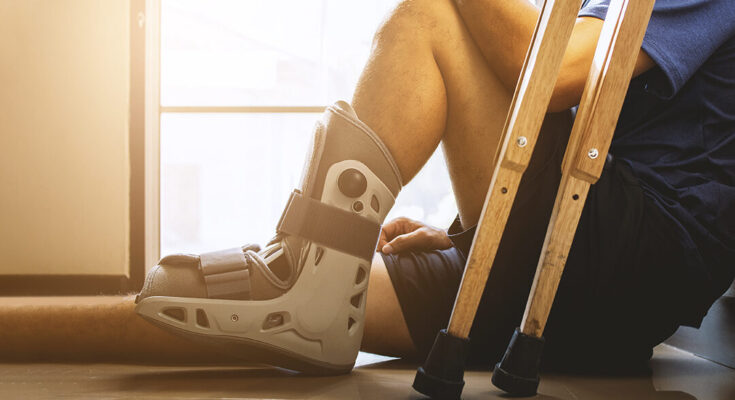Broken Foot Treatment: A broken foot, a common yet often complex injury, requires meticulous care and expert guidance for effective healing and recovery.
Understanding the intricacies of its diagnosis and the nuances of its treatment can significantly impact the recovery process.
What is a Broken Foot
A broken foot, a common yet often debilitating injury, can significantly impact an individual’s daily activities. Understanding the causes, types, and symptoms of foot fractures is essential for timely diagnosis and effective treatment.
Common Causes and Types of Foot Fractures
Foot fractures can occur from various causes, ranging from accidents to overuse. Common causes include:
- Traumatic Injuries: Accidents, such as falls, sports injuries, or direct blows to the foot.
- Overuse: Repeated stress on the foot, typical in athletes or individuals with high-impact lifestyles.
- Medical Conditions: Osteoporosis or other bone-weakening diseases can predispose individuals to fractures.
Types of foot fractures vary based on the location and severity of the break. They include:
- Stress Fractures: Small cracks in the bone, usually due to repetitive stress.
- Toe Fractures: Commonly caused by stubbing a toe or dropping something heavy on the foot.
- Metatarsal Fractures: Involving the long bones in the foot, often resulting from a twisting injury or a fall.
- Heel Fractures: Typically caused by a high-impact event like a fall from a height.
Symptoms to Watch For
Recognizing the symptoms of a broken foot is crucial for prompt treatment. Key symptoms include:
- Pain: Often immediate and intensifying with movement or pressure.
- Swelling and Bruising: Visible swelling and discoloration around the affected area.
- Difficulty Walking: A notable challenge in bearing weight or walking.
- Deformity: In severe cases, the foot may appear misshapen or abnormally positioned.
A broken foot, while common, requires immediate medical attention. Understanding its causes, types, and symptoms aids in early recognition and treatment, ultimately leading to better recovery outcomes. If you suspect a foot fracture, consult a healthcare professional for a proper diagnosis and treatment plan.
Diagnosis of a Broken Foot
This article outlines the steps involved in diagnosing a broken foot, emphasizing the role of imaging tests like X-rays, and highlights the importance of professional medical evaluation.
Steps in Diagnosing a Broken Foot
Initial Consultation: The first step in diagnosing a broken foot is an initial consultation with a healthcare professional. This usually involves discussing the circumstances of the injury, symptoms, and medical history.
Physical Examination: A thorough physical examination is conducted to assess the extent of the injury. The doctor will look for signs of swelling, bruising, tenderness, and deformity.
Pain Assessment: Understanding the intensity and location of pain helps in pinpointing the affected area. This assessment is crucial in determining the next steps.
The Role of X-Rays and Other Imaging Tests
X-rays: The most common and crucial imaging test for a broken foot is an X-ray. It helps in visualizing bone fractures and determining their severity and location.
CT Scans and MRIs: In cases where more detailed images are needed, especially for complex fractures, CT scans or MRIs might be recommended.
Bone Scans: Occasionally, if a stress fracture is suspected which might not show up on an X-ray, a bone scan may be advised.
Importance of Professional Medical Evaluation
Accurate Diagnosis: A professional medical evaluation ensures an accurate diagnosis, crucial for effective treatment.
Treatment Planning: Based on the diagnosis, a healthcare provider can develop a personalized treatment plan, which may include casting, splinting, or in severe cases, surgery.
Monitoring Healing: Regular follow-up appointments are essential to monitor the healing process and make any necessary adjustments in treatment.
However, diagnosing a broken foot involves a systematic approach that starts from initial consultation to detailed imaging tests. The role of professional medical evaluation cannot be overstated, as it ensures not only accurate diagnosis but also effective treatment and recovery.
Initial Steps in Treating a Broken Foot
Experiencing a foot injury can be alarming, especially if you suspect it might be a break. It’s crucial to handle such situations with care. Here are the initial steps you should take if you suspect a broken foot:
First-Aid Measures for a Suspected Broken Foot:
- Rest: Avoid putting any weight on the injured foot. Resting minimizes further injury and reduces swelling.
- Ice: Apply ice packs to the injured area for 15-20 minutes every few hours. This helps reduce swelling and pain.
- Compression: Use a soft bandage to wrap the foot. Ensure it’s snug but not too tight to cut off circulation.
- Elevation: Elevate the foot above heart level to reduce swelling. This can be done by propping it up on pillows.
When to Seek Immediate Medical Attention:
- Severe Pain: If the pain is unbearable or gets worse, it’s a sign to get medical help.
- Deformity: If the foot looks deformed or out of place, this could indicate a severe break.
- Open Wound: Any break in the skin, especially with visible bone, needs urgent medical care.
- Numbness or Tingling: These symptoms might suggest nerve damage.
- No Improvement: If symptoms don’t improve with first-aid measures, consult a healthcare provider.
Remember: While these steps are helpful, they are not a substitute for professional medical advice. Always consult a healthcare provider for proper diagnosis and treatment.
Professional Treatment Options for a Broken Foot
These methods vary based on the severity and type of fracture. Generally, treatment can be divided into non-surgical and surgical options.
Non-Surgical Treatments
- Casting: A cast is often the go-to solution for a broken foot. It immobilizes the bones, allowing them to heal correctly. The type of cast and the duration it needs to be worn depend on the fracture’s severity.
- Splinting: Similar to casting, splinting also helps in immobilizing the affected area. Splints are typically used for minor or stable fractures and can be adjusted for swelling.
- Rest: Perhaps the most crucial aspect of treatment, rest, plays a vital role in healing a broken foot. It involves limiting weight-bearing activities to give the bones time to heal naturally.
Surgical Options
Surgery is considered when the fracture is severe, complicated, or when non-surgical methods are ineffective.
- When is Surgery Needed?: Surgery may be required in cases of multiple fractures, displaced bones, or fractures not responding to casting or splinting.
- What Does Surgery Involve?: Surgical treatment usually involves realigning the fractured bones and securing them with screws, plates, or rods. This process aids in proper healing and restores function to the foot.
However, the choice between non-surgical and surgical treatment depends on various factors, including the type of fracture, severity, and the patient’s overall health. It’s essential to consult with a healthcare professional for an accurate diagnosis and appropriate treatment plan.
Recovery and Rehabilitation
Recovering from a broken foot is a journey that varies based on the severity of the break and individual health factors. Generally, a typical recovery timeline can be outlined as follows:
- Immediate to 6 Weeks: The early phase focuses on healing and avoiding further injury. This period typically involves rest, ice, compression, and elevation (RICE). Casts or boots are commonly used to immobilize the foot, ensuring proper alignment and healing.
- 6 to 12 Weeks: This stage sees gradual improvements. Patients may start to bear weight, as advised by their doctor. Regular check-ups are crucial to monitor the healing process.
- 3 to 6 Months: As healing progresses, more mobility is often introduced. Depending on the break’s severity, most people begin to walk more comfortably and return to normal activities.
- 6 Months and Beyond: Full recovery can take up to a year, especially for severe breaks. Continuous monitoring and follow-up appointments are vital to ensure complete healing.
Physical Therapy and Rehabilitation Exercises
Physical therapy plays a critical role in the recovery process. Key components include:
- Strength Building: Exercises targeting foot and ankle muscles help regain strength.
- Flexibility and Mobility: Stretching exercises improve flexibility, reducing stiffness and increasing range of motion.
- Balance and Coordination: Balance exercises are crucial to restore stability and prevent future injuries.
It’s important to follow a tailored exercise regimen provided by a physical therapist for optimal recovery.
Tips for a Successful Recovery
- Adhere to Medical Advice: Always follow the guidance of healthcare professionals.
- Stay Active Within Limits: Engage in approved activities to maintain overall health.
- Nutrition Matters: A balanced diet rich in calcium and vitamin D supports bone healing.
- Be Patient and Positive: Recovery takes time, and a positive mindset can significantly impact the healing process.
Remember, every individual’s recovery journey is unique. Regular consultations with healthcare providers are essential to tailor the recovery plan to individual needs and progress.
Prevention and Care
Preventing foot injuries is crucial for maintaining mobility and overall well-being. Here are effective strategies to minimize the risk:
Wear Proper Footwear: Choosing shoes that fit well and provide adequate support is essential. This is particularly important for athletes and individuals who stand for long periods.
Maintain Healthy Weight: Excess weight puts additional stress on your feet. Maintaining a healthy weight can reduce the risk of foot injuries.
Regular Exercise: Engaging in exercises that strengthen the foot muscles can help protect against injuries. Activities like walking, swimming, or cycling are beneficial.
Foot Hygiene: Keeping your feet clean and dry prevents infections that could weaken your feet and lead to injuries.
Avoid Walking Barefoot: Especially on hard or uneven surfaces, as this exposes feet to potential harm.
Regular Foot Check-ups: Especially for people with diabetes or circulatory problems, regular check-ups can help in early identification and prevention of foot complications.
Importance of Follow-Up Care and Monitoring
After sustaining a foot injury, follow-up care and monitoring are pivotal for a full recovery. Here’s why:
Prevents Complications: Regular check-ups ensure that the injury is healing correctly and helps in preventing complications.
Adjustments in Treatment: Follow-up care allows for adjustments in treatment if the current plan isn’t effective.
Physical Therapy: In some cases, physical therapy may be necessary to regain strength and mobility.
Monitoring for Infection: It’s important to monitor for signs of infection, which can worsen the injury and delay recovery.
Guidance on Return to Activity: Healthcare providers can give advice on when and how to safely return to normal activities or sports.
Incorporating these prevention and care strategies into your routine can significantly reduce the risk of foot injuries and ensure proper recovery if an injury does occur. Prioritizing foot health is a step towards overall physical wellness.
FAQs: Broken Foot Treatment
What is the best way to treat a broken foot?
Treatment for a broken foot typically involves immobilization, which may include wearing a cast, boot, or brace. It’s important to rest the foot and keep it elevated to reduce swelling. Over-the-counter pain medication can help manage discomfort. In some cases, surgery may be necessary, especially for more severe fractures.
How long does it take for a broken foot to heal?
The healing time for a broken foot varies depending on the severity of the fracture and the individual’s overall health. On average, it takes about six to eight weeks for a broken bone to heal. However, it may take longer for the foot to fully recover and regain strength.
Can I walk on a broken foot?
Walking on a broken foot is generally not advised as it can worsen the injury and delay healing. Your doctor will advise you on when it’s safe to bear weight on your foot. This typically happens after the bone has started to heal, which may be several weeks after the injury.
What are the signs that my broken foot is healing properly?
Signs that your broken foot is healing properly include reduced pain and swelling, increased mobility, and the ability to bear weight without discomfort. Your doctor will monitor your progress through follow-up visits and possibly X-rays to ensure proper healing.
What should I avoid doing with a broken foot?
Avoid putting weight on the injured foot until your doctor advises it’s safe. Also, avoid activities that could cause further injury, such as running, jumping, or strenuous exercise. It’s important to follow your doctor’s instructions carefully to ensure proper healing.
When should I see a doctor for a broken foot?
Seek medical attention if you suspect a broken foot, especially if you experience severe pain, swelling, bruising, or difficulty moving the foot. Prompt treatment is crucial for proper healing and to prevent complications.
Conclusion
Ignoring symptoms or delaying treatment can exacerbate the injury, leading to more complex and prolonged recovery processes.
Thus, prioritizing your health by promptly consulting a healthcare provider ensures the best possible recovery and helps maintain your foot health and overall well-being.
Remember, when it comes to health, especially concerning something as foundational as your feet, professional guidance is key to a swift and effective recovery.


